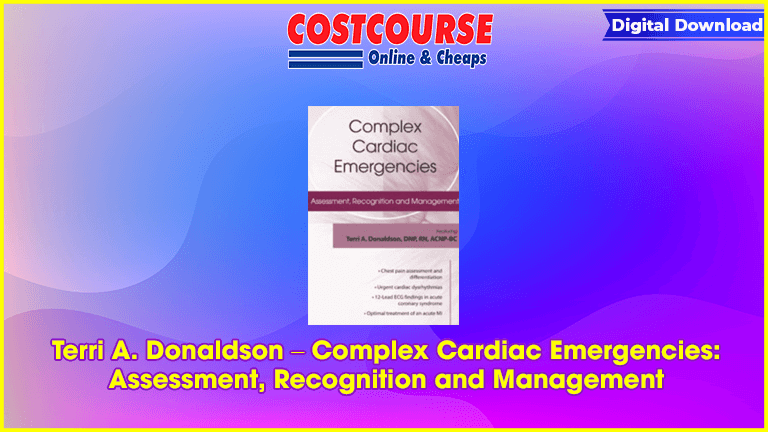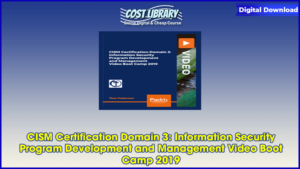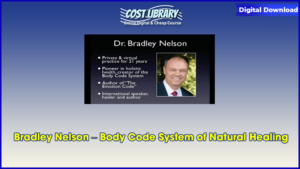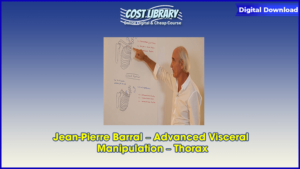Description
Course Description:
When faced with a cardiac emergency, you know that response time is critical. The challenge is to make the best use of that very tight time frame in terms of your patient’s urgent care needs.
Terri A. Donaldson – Complex Cardiac Emergencies: Assessment, Recognition and Management
Attend this practical and comprehensive program and gain the skills and knowledge you need to quickly detect the early warning signs of an emergent cardiac situation. Learn focused assessment techniques and the latest intervention strategies to confidently set and manage treatment priorities, minimize complications and improve patient outcomes.
Drawing on over 23 years of cardiac and critical care nursing, Terri Donaldson will share with you the latest evidence-based approaches to evaluating and treating patients presenting with acute cardiac problems. Through interactive discussion and hands-on learning, you will have the opportunity to enhance your ECG interpretation skills, analyze urgent cardiac care case scenarios and explore the leading-edge response techniques. You will leave with a renewed commitment to achieving excellence in cardiac care.
Objectives:
At the completion of this program, you should be able to:
Differentiate the etiologies of chest pain, including acute coronary syndrome, pulmonary embolism, and aortic dissection.
Identify the electrocardiographic changes associated with acute coronary syndrome.
Analyze the pharmacological and non-pharmacological treatment strategies for acute coronary syndrome.
Utilize evidenced-based practice to describe optimal patient outcomes for the patient experiencing acute coronary syndrome.
Distinguish the variant electrocardiographic changes that imitate myocardial infarction.
Determine the management priorities in the care of the patient experiencing crises associated with acute myocardial infarction, including cardiogenic shock, right ventricular infarction, and mechanical complications.
Describe the cardiac dysrhythmias that require urgent or emergent intervention.
Examine the clinical presentation, exam findings, and treatment of cardiac tamponade.
Handouts
Printable Materials (20 MB) Available after Purchase
Outline
Acute Coronary Syndrome (ACS)
Unstable angina/NSTEMI
STEMI
Assessment of chest pain
Atypical presentations
Diagnosis of ACS
Cardiac biomarkers
Electrocardiographic changes
Ischemia
Injury
Infarction
Diagnostic studies
Rest and stress imaging studies
Stress testing
Cardiac catheterization
Coronary angiography
Evidenced-based guidelines for management of ACS
Pharmacologic management
Reperfusion options
Selection of strategies
Pharmacologic reperfusion
Percutaneous coronary intervention (PCI)
Surgical reperfusion
Ancillary therapy
Imposters and Variants
12-Lead ECG
Early repolarization
Hypertrophy
Pericarditis
Cor pulmonale
Chest pain
Pericarditis
Pulmonary embolism
Aortic dissection
Management decisions
Complications of Myocardial Infarction
Cardiogenic shock
Hemodynamic parameters
Pharmacogical management
Mechanical assist devices
Right ventricular infarction
Clinical presentation and diagnosis
Management strategies
Mechanical complications and management strategies
Ventricular septal defect
Left ventricular free wall rupture
Left ventricular aneurysm
Papillary muscle rupture
Urgent/Emergent Cardiac Dysrhythmias
Ventricular dysrhythmias
Heart block
Supraventricular rhythms
Atrial tachycardia
Atrial fibrillation/flutter
Re-entry tachycardias
Wolff-Parkinson-White
Junctional tachycardia
Management approaches
Cardiac Tamponade
Etiology
Clinical presentation
Physical exam findings
Diagnosis and management
What’s on the Horizon for Cardiac Nursing?








